To Resize Object Has a Bad Format Dg Photo Art V5
Sigma 24-70mm f/2.8 DG DN Art Lens Review
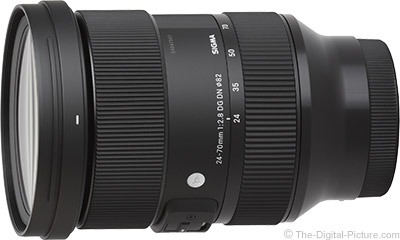
A 24-70mm f/2.eight lens is a staple in a high percent of photographers' kits, and Sigma's 24-70mm f/2.8 DG DN Art Lens has the boosted properties required to get in a #1 seller at B&H.
This lens is well built, nicely designed, optically excellent, and very reasonably priced. That the focal length range and wide aperture combination is then useful means that this lens will oft exist mounted, making its value very high.
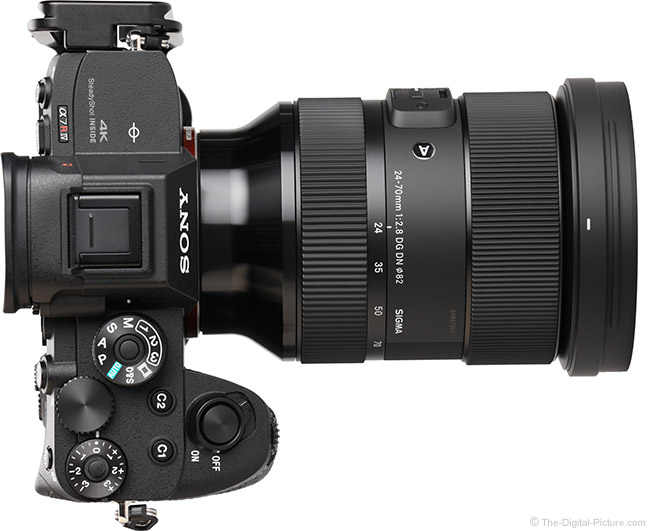
Focal Length Range
The focal length range (or private focal lengths for prime lenses) is a primary consideration for a lens purchase or selection for use. Focal length matters profoundly because information technology drives focus altitude choices, and perspective is adamant by those distances. Most subjects tin be photographed with any focal length, but not all angles of view provided past those focal lengths are applied from a working altitude perspective, and they practice not all provide the ideal perspective when the desired subject area framing is obtained. For instance, photographing a grouping of 15 people with a 600mm lens requires a working distance that might crave a big sports field to keep all group members in the frame, and a phone may exist required to communicate with them.
The broad-bending through brusk telephoto 24-70mm focal length range covers a huge range of full general-purpose needs, making it an ideal option for photographing a vast range of subjects. This is the type of lens that you can accept when you are not sure which focal lengths yous will need and ordinarily, it will be found to be the right choice.
The 24-70mm range is great for photographing people, and it is platonic for portraits, weddings, parties, events, family gatherings, documentaries, interviews, lifestyle, theater, fashion, studio portraiture, candids, and even some sports. Utilize 70mm for head and shoulders portraits and the wider end for group portraits and ecology imagery.
This lens is a perfect option for media and photojournalistic needs. It is a keen option for street photography.

This lens is an excellent option for landscape and cityscape photography with ideal compositions waiting for every focal length available in this lens. It is not difficult to create compelling mural compositions using the 24mm perspective, allowing accent on a foreground field of study against an in-focus background, providing the viewer a sense of presence in the scene. At the other finish of the range, 70mm works swell for mildly-compressed landscapes featuring distant subjects such as mountains.
With a wide aperture, this lens is attractive for photographing the night sky with the 24mm end being of almost involvement in that regard.
This lens is well-suited for commercial photography, and the wide finish of the range is fix to capture exterior architecture and larger interior spaces. Cityscapes, countrysides, flowers, medium and large products, and much more are on this lens' capabilities list.
Following are examples of this focal length range:

APS-C imaging sensor format cameras use a smaller portion of the prototype circle, framing a scene more than tightly. The Sony field of view ingather gene is 1.5x, with the 24-70mm range providing a 36-105mm full-frame angle of view equivalent. This angle of view has greater value for portraiture while foregoing some of the best landscape angles.

Max Aperture
As of review time, very few zoom lenses have a maximum aperture opening wider than this i, and simply ane of those covers most of this lens' focal length range. A wide discontinuity is a big feature advantage this lens holds.
Broad apertures are useful for stopping activeness, both that of the subject and that of the camera, in low light levels while keeping ISO settings low. While having an f/two.viii discontinuity may not be greatly advantageous from ISO and shutter speed perspectives when photographing under bright lite (daylight, for example), the story is dissimilar in low low-cal scenarios.
Wide apertures do good AF systems, enabling them to work better in depression light environments. Even when photographing under bright calorie-free conditions, wide apertures are useful for creating a potent background blur that makes a subject cleanly stand out, isolated from even highly distracting backgrounds.
Hither is an case of the maximum background blur this lens can produce at the specified focal lengths:
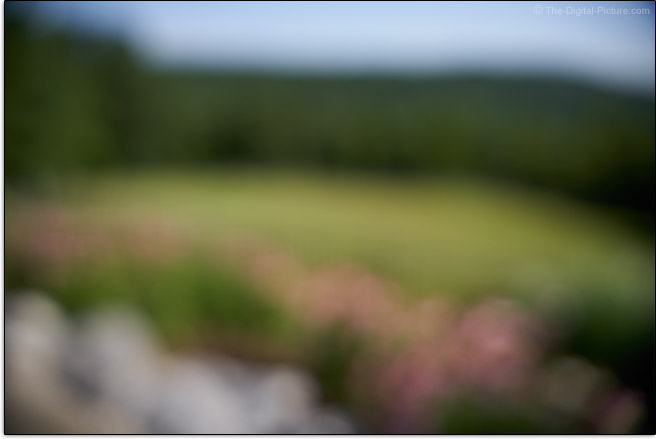
Remember that broad-angle lenses render the groundwork details smaller in size? That includes the background blur. Still, this lens can create a potent amount of background blur, fifty-fifty at 24mm.
A disadvantage of a wide aperture is the required increased concrete size of the lens elements that come with heavier weight and higher cost. This lens keeps especially that last factor in check.

Image Stabilization
The Sigma 24-70mm f/2.8 DG DN Art Lens is not optically stabilized, but Sony generally takes care of that omission with Steady Shot or IBIS (In-Torso Image Stabilization). On a traditional DSLR with an optical viewfinder, IBIS results in an unstabilized view, significant that stabilization was not helpful for composition or for providing a nevertheless subject to the camera's AF system. With EVFs being prevalent in Sony's compatible Due east-mount lineup, the viewfinder paradigm is directly from the imaging sensor, which is stabilized. Therefore, the viewfinder prototype is very nicely stabilized, and sensor-based AF takes advantage of the stabilized view for improved accuracy.
With no IS switch on the lens, the camera menu must be used to enable or disable IBIS, an boosted step that is annoying when speed is of import such as when going from tripod to handheld.
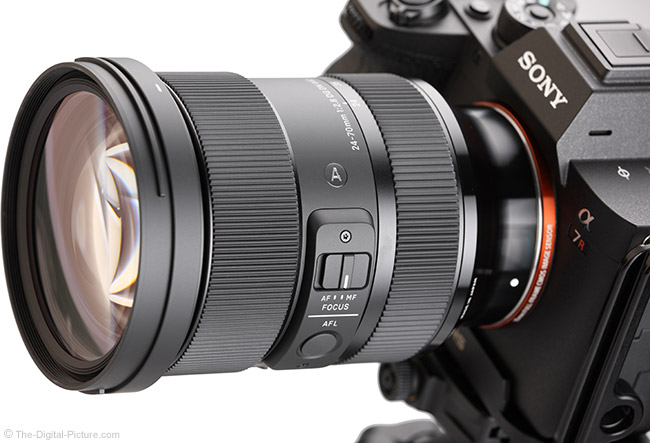
Paradigm Quality
Best-selling lenses ordinarily accomplish that status in part because they take fantabulous optical functioning. This lens checks that box.
Sharpness, a combination of contrast and resolution, is a master optical quality we are interested in. Photographers desire, minimally, the choice of keeping their subjects sharp.
In the center of the frame, this lens is very abrupt wide-open throughout the entire focal length range. At the focal length extents, very minor sharpness increase is realized by selecting a narrower aperture. In the midrange, stopping down brings on more noticeable sharpness increase, at to the lowest degree at closer distances.
In lens designs, light rays are increasingly bent as the image circumvolve radius increases, and peripheral performance seldom matches the heart of the frame performance. In this case, f/2.8 peripheral results at the broad and long ends are very expert, and the midrange operation is simply modestly lower. Minor sharpness improvement is brought on by selecting a narrower aperture.
Adjacent, let's view some real-world examples. Below you volition detect sets of 100% resolution center of the frame crops captured in uncompressed RAW format using a Sony a7R 3. The images were candy in Capture One using the Natural Clarity method with the sharpening amount set to only "30" on a 0-1000 calibration. Annotation that even modestly-high sharpness settings are subversive to image details, hiding the truthful characteristics of a lens.

All of these results look excellent.
In some lens designs, the aeroplane of sharp focus tin move forward or backward as a narrower discontinuity is selected. This issue is called focus shift (remainder spherical aberration or RSA), it is seldom (never?) desired, and this lens does not exhibit such.
Adjacent, we'll look at a comparison showing 100% extreme-top-left-corner crops captured and processed identically to the above center-of-the-frame images. The lens was manually focused in the corner of the frame to capture these images.

Right, the 40mm results are missing. I didn't catch a problem with the exam images until the lens was gone. Use the prototype quality exam chart for the midrange results. Wait 40mm to provide performance similar to what is seen above.
Samples taken from the outer extreme of the image circle, full-frame corners in this case, can exist counted on to show the worst performance a lens is capable of. The 24mm results are impressive, and the 70mm results are non bad.
Corner sharpness does not always matter, but it does matter for many disciplines, including landscape and architecture photography. This lens is a swell choice for those purposes.
When used on a camera that utilizes a lens's entire image circle, peripheral shading tin be expected at the widest aperture settings. At 24mm, expect about 3-stops of shading in the extreme full-frame corners. The shading improves slightly at the longer focal lengths, with about 2-stops of concealment in the extreme corners. Vignetting continuously clears as the aperture is narrowed, but the per-stop reduction is low. At f/16, a relatively stiff about-1.six-stops of shading remains in the 24mm corners. The longer focal lengths once again fare better with about 0.five-stops remaining at 70mm f/16.
APS-C format cameras using lenses projecting a full-frame-sized image circumvolve avert vignetting problems with this lens.
1-stop of shading is the amount often used as the visibility number, though subject details provide a widely varying amount of vignetting discernibility. Vignetting is correctable during mail service-processing with increased noise in the brightened areas being the penalty, or it tin can be embraced, using the effect to depict the viewer'southward eye to the eye of the frame. Study the blueprint showing in our vignetting test tool to determine how your images will be affected.
The event of different colors of the spectrum being magnified differently is referred to as lateral (or transverse) CA (Chromatic Aberration). Lateral CA shows as color fringing along lines of stiff contrast running tangential (meridional, right angles to radii) with the mid and especially the periphery of the image circumvolve showing the most meaning amount every bit this is where the about significant difference in the magnification of wavelengths typically exists.
With the correct lens profile and software, lateral CA is often easily correctable (oft in the photographic camera) by radially shifting the colors to coincide. However, information technology is ever improve not to accept the problem in the first identify. Whatever color misalignment present can hands be seen in the site's epitome quality tool, but let'south likewise look at a fix of worst-example examples. These are 100% crops from the extreme top left corner of ultra-high-resolution Sony a7R IV frames showing diagonal black and white lines.

In that location should only be black and white colors in these images, with the boosted colors indicating the presence of lateral CA. Non unusual is for a zoom lens to have noticeable color separation in the corners at the focal length extremes (with the fringing colors beingness reversed) with mid-range focal lengths showing little lateral CA. The color shift crossover (colors aligning and and then reversing) happens at approximately 40mm where little color shift is seen.
A relatively mutual lens abnormality is axial (longitudinal, bokeh) CA, which causes non-coinciding focal planes of the various wavelengths of light, or more only, different colors of light are focused to different depths. Spherical aberration forth with spherochromatism, or a change in the amount of spherical aberration with respect to colour (looks quite similar to axial chromatic abnormality just is hazier) are other mutual lens aberrations to notice. Axial CA remains at least somewhat persistent when stopping down with the color misalignment outcome increasing with defocusing. The spherical aberration color halo shows little size change as the lens is defocused, and stopping downwardly one to two stops generally removes this aberration.
In the real world, lens defects practice not exist in isolation with spherical aberration and spherochromatism generally plant, at to the lowest degree to some degree, along with axial CA. These combine to create a less sharp, hazy-actualization paradigm quality at the widest apertures.
In the examples below, look at the fringing colors in the out of focus specular highlights. Created by the neutrally-colored subjects, fringing color differences were introduced by the lens.

The 24mm and 35mm examples evidence modest color separation. The 50mm results show strong color separation, and the 70mm results show very potent colour separation.
Flare and ghosting are acquired by bright calorie-free reflecting off the surfaces of lens elements, resulting in reduced contrast and sometimes-interesting artifacts. Sigma utilizes Super Multi-Layer and Nano Porous Coatings to combat these issues. With a wide-open discontinuity, this lens shows very minor flare furnishings in our sun in the corner of the frame examination. F/16 usually brings on stronger flaring, and this lens indeed shows more flare effects at this narrow aperture. Nevertheless, the amount is non stiff.
Flare effects can exist embraced or avoided, or removal tin can be attempted. Removal is sometimes very challenging, and in some cases, flare effects can exist quite subversive to epitome quality.
Two lens aberrations that are particularly evident when shooting images of stars, mainly because bright points of low-cal against a dark background make them easier to run into. Coma occurs when low-cal rays from a point of calorie-free spread out from that point, instead of being refocused every bit a point on the sensor. Coma is absent in the middle of the frame, gets worse toward the edges/corners, and generally appears every bit a comet-like or triangular tail of calorie-free which can exist oriented either away from the center of the frame (external blackout), or toward the eye of the frame (internal coma). Coma clears equally the aperture is narrowed. Astigmatism is seen as points of light spreading into a line, either sagittal (radiating from the center of the prototype) or meridional (tangential, perpendicular to sagittal). Remember that lateral CA is another aberration apparent in the corners.
The images beneath are 100% crops taken from the top-left corner of a7R III frames.

While these results are not unusual for a lens in this form, they are not bang-up.
This is a standard zoom lens, and the standard zoom lens geometric baloney argument holds. This lens has barrel distortion at the wide end that transitions into negligible distortion (at merely wider than 35mm) and on into pincushion baloney at the long stop. The amount of barrel distortion at 24mm is moderate, with a strong bulge in the cardinal portion of the frame. The pincushion distortion at 50mm through 70mm is moderately strong. These amounts are not unusual for this class of lens.
Well-nigh modern lenses have lens correction profiles bachelor, and distortion tin easily be removed using these. Nonetheless, distortion correction is destructive at the pixel level as some portion of the image must be stretched, or the overall dimensions reduced.
The amount of mistiness a lens can produce is easy to show, and every bit seen earlier in the review, this lens can create a potent blur. Assessing the quality is more challenging due in role to the infinite number of variables present among all available scenes. Hither are some f/xi (for aperture blade interaction) examples.

The first set of examples show defocused highlights. These are being rendered peculiarly circularly, though the fill seems slightly mottled. The second set up testify 100% crops from outdoor scenes, results that appear nice.
Except for a small-scale number of specialty lenses, the wide aperture bokeh in the corner of the frame does not produce round defocused highlights with these effects taking on a true cat'south eye shape due to a grade of mechanical vignetting. If you look through a tube at an angle, similar to the low-cal reaching the corner of the frame, the shape is not round. That is the shape seen here.

The 24mm corner element truncation is relatively strong, while the 40mm and 70mm results show only the deep corner highlights being unrounded. As the discontinuity narrows, the archway pupil size is reduced, and the mechanical vignetting absolves with the shapes becoming rounder.
With a very high 11-blade count aperture, point lite sources captured with a narrow aperture setting and showing a sunstar effect will have 22 points. In full general, the more a lens is stopped down, the larger and better-shaped the sunstars tend to exist. Wide aperture lenses tend to be advantaged in this regard, and for that reason, I often select a wider discontinuity lens than is required by other constraints. This lens can produce cute stars.

The examples in a higher place were captured at f/xvi. In general, the wider the focal length used on a fixed max aperture zoom lens, the better shaped the sunstars are due to the aperture opening being made considerably smaller at 24mm than at 70mm to achieve the same aperture setting.

The design of this lens is illustrated above and described below.
"As extra-low dispersion glass materials, six sheets of "F" low dispersion (FLD) drinking glass and two sheets of special low dispersion (SLD) drinking glass are lavishly employed while taking advantage of an optical design dedicated for mirrorless lenses. By employing three aspheric lenses, this zoom lens thoroughly subdues aberrations such equally centric chromatic abnormality or sagittal blackout aberrations, which are hard to correct in mail-processing, tailors the resolution and achieves uniformity and superior optical performance from the center to the periphery throughout the zoom range." [Sigma]
While the color fringing is strong at the long stop, and lateral CA, vignetting, coma, and distortion results are merely boilerplate. Yasuhiro Ohsone (Head of Product Planning, SIGMA) mentions, "Leaving distortion correction and vignetting reduction to the camera'southward image processing allows u.s. to focus on a higher effectiveness of other optical corrections and take more than liberty in our optical design." The sharp images produced by this lens overshadow the other issues, resulting in a very-high-performing lens.
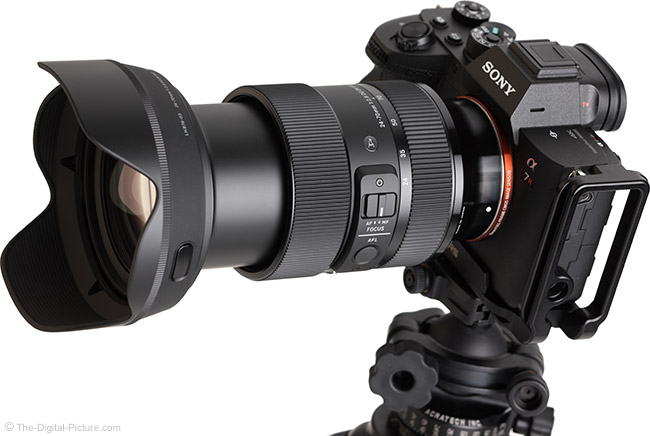
Focusing
Sigma describes the AF system in this lens: "Employing a stepping motor and the latest algorithm successfully establishes a good balance between acceleration and quietness of the AF drive."
This lens focuses with proficient speed, bated from the a7R 3 and IV insisting on defocusing before refocusing in AF-Due south manner. Accuracy is a key factor for AF, and accuracy is what this lens delivers.
Sigma provides an AFL (AF Lock) push button. While in continuous focus mode, this push button can be pressed to lock focus at the currently selected focus distance, permitting a focus and recompose technique. This button also acts as a custom button (C5) and can be programmed to another function using the photographic camera's menu.
FTM (Full Time Manual) focusing is supported in Sony'due south DMF (Direct Manual Focus) AF way.
Normal is for the scene to change size in the frame (sometimes significantly) as the focus is pulled from one extent to the other, referred to equally focus animate, a modify in focal length resulting from a modify in focus distance. Focus animate negatively impacts photographers intending to use focus stacking techniques, videographers pulling focus, and anyone very-critically framing while adjusting focus. This lens shows a moderate change in discipline size equally total extent focus adjustments are fabricated at the wide end, but minor size alter is observed at the long end.

A focus distance window is not provided, but a focus distance meter shows in the lower portion of the camera'southward electronic viewfinder during manual focusing.
While it tin can be an private lens-specific attribute, parfocal-like behavior is a feature of the reviewed lens. When focused at 70mm and zoomed to 24mm, the subject remained at to the lowest degree very close to sharply focused.

The Sigma 24-70mm f/2.8 DG DN Art Lens provides a large focus band, ideally positioned toward the front of the lens. This strongly-rubber-ribbed ring is raised slightly from the lens butt, making it easy to find. With 320° of nicely-resisted rotation provided, this electronic manual focus ring is easy to adjust precisely.
With a minimum focus distance of 7.1" (180mm), this lens's 0.34x maximum magnification spec does not disappoint.
| Model | MFD | MM | |
| Canon RF 24-70mm F2.8 L IS USM Lens | eight.three" | (210mm) | 0.30x |
| Nikon Z 24-70mm f/2.eight S Lens | 15.0" | (380mm) | 0.22x |
| Sigma 24-70mm f/2.8 DG DN Art Lens | 7.one" | (180mm) | 0.34x |
| Sony FE 24-70mm f/two.8 GM Lens | xv.0" | (380mm) | 0.24x |
| Tamron 28-75mm f/2.eight Di III RXD Lens | 7.5" | (190mm) | 0.34x |
At 24mm, a subject measuring approximately 4.0 10 ii.7" (102 ten 68mm) fills the frame of a full-frame camera at the minimum focus distance. At 70mm, an approximately 5.25 ten 3.5" (133 x 89mm) subject fills the frame at the minimum focus distance.
The minimum focus altitude is measured from the imaging sensor airplane with the residue of the camera, lens, and lens hood length taking their space out of the number to create the working distance. At the minimum focus altitude at 70mm, there is plenty of working altitude, merely at 24mm, the aeroplane of precipitous focus is behind the lens hood. Removing the hood is required for using the minimum focus distance at 24mm, just the lens will usually touch on the subject field lighting.
Need a shorter minimum focus distance and higher magnification? An extension tube mounted behind this lens should provide a very significant decrease and increase, respectively. That is if there is however room betwixt the lens and the discipline — certain to be an issue at the wide finish.
Extension tubes are hollow lens barrels that shift a lens farther from the camera, assuasive shorter focusing distances at the expense of long-distance focusing. Electronic connections in the extension tubes permit the lens and photographic camera to communicate and otherwise office every bit normal. Sigma does not publish extension tube specs, nor exercise they manufacture these items, only third-party Sony-mountain extension tubes are available.
This lens is not uniform with Sigma or Sony teleconverters.

Build Quality & Features
Sigma's Art series lenses all have excellent build quality and adept looks to match.

The sharply-prophylactic-ribbed zoom ring is nicely sized, easy to notice, and shine to apply. The butt extends 1.27" (32.2mm) at 70mm, with the extended barrel having no noticeable play. The end of the barrel contributes significantly to the maximum width of this lens.
An AF/MF switch is provided forth with the previously mentioned AFL button on a modestly-raised panel. A zoom lock switch is provided below the console, enabling the lens to be locked in its fully retracted size.

"The lens adapts to diverse uses and usage environments through employment of the dust- and splash-proof structure." [Sigma]

Lenses in this class have (mostly) like size and weight. These are not specially small-scale or lite models, merely they are not uncomfortable to use for extended shoots or to bear in a pack or case. The Tamron option is the outlier in this comparison.
| Model | Weight oz(g) | Dimensions west/o Hood "(mm) | Filter | Year | ||
| Canon RF 24-70mm F2.8 L IS USM Lens | 31.8 | (900) | 3.v x 4.ix | (88.5 x 125.7) | 82 | 2019 |
| Nikon Z 24-70mm f/2.viii S Lens | 28.4 | (805) | 3.five x 5.0 | (89.0 x 126.0) | 82 | 2019 |
| Sigma 24-70mm f/2.viii DG DN Art Lens | 29.five | (835) | 3.v 10 4.viii | (87.8 x 122.9) | 82 | 2019 |
| Sony FE 24-70mm f/2.viii GM Lens | 31.3 | (886) | 3.4 ten v.four | (87.6 ten 136.0) | 82 | 2016 |
| Tamron 28-75mm f/2.8 Di III RXD Lens | 19.4 | (550) | ii.nine x 4.6 | (73.0 x 117.8) | 67 | 2018 |
For many more comparisons, review the complete Sigma 24-70mm f/2.eight DG DN Art Lens Specifications using the site'south lens specifications tool.
Yes: My knuckles slightly touch on the barrel of this lens when using the Sony a7R IV.
Hither is a visual comparison:
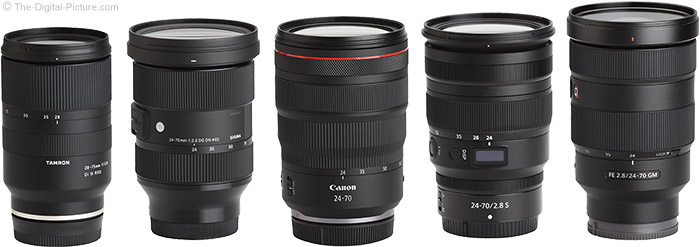
Positioned higher up from left to right are the post-obit lenses aligned on their mounts:
Tamron 28-75mm f/2.8 Di Three RXD Lens
Sigma 24-70mm f/2.viii DG DN Art Lens
Canon RF 24-70mm F2.8 50 IS USM Lens
Nikon Z 24-70mm f/2.viii S Lens
Sony Atomic number 26 24-70mm f/ii.viii GM Lens
The same lenses are shown below with their hoods in place.

Utilise the site's product image comparison tool to visually compare the Sigma 24-70mm f/2.8 DG DN Art Lens to other lenses.
The Sigma is modestly smaller than the Sony, but noticeably larger than the Tamron.
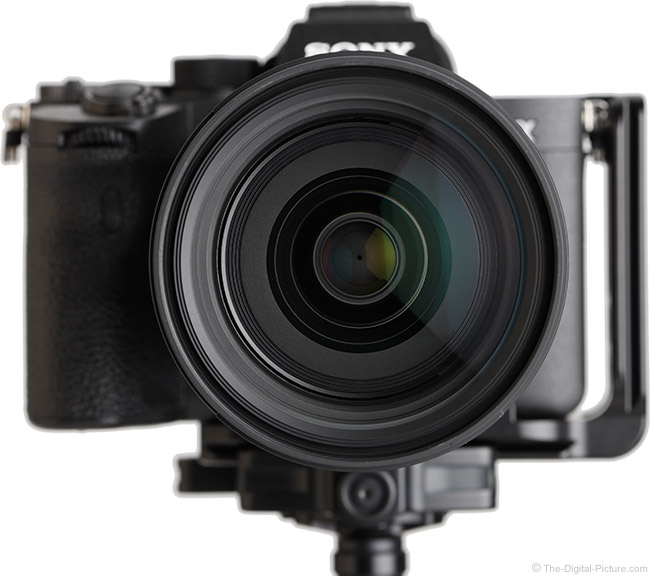
The 82mm filter thread size is almost standard for this class of lens. While 82mm filters are rather large and expensive, they have go quite common and tin be adapted to about other filter thread sizes. A standard thickness circular polarizer filter will increment peripheral shading. Opt for a slim model such as the Breakthrough Photography X4.

We can count on Sigma to include the lens hood in the box, and this lens comes with the substantial LH878-03 lens hood model. This is a semi-rigid plastic petal-shaped hood with a ribbed interior designed to avoid reflections. A thin ribbed band and rubberized rear section are provided for easy grip, with the push button making installation and removal easy. This hood offers a good amount of protection from both touch on and, especially at broad focal lengths, from bright calorie-free.

Sigma provides a nice zippered, padded nylon instance in the box.

Toll, Value, Wrap Up
At roughly half the toll of the Sony equivalent, and with solid overall build and functioning, the Sigma 24-70mm f/two.8 DG DN Art Lens is a dandy value. Information technology is non surprising that this lens is a #1 bestseller.
The Sigma 24-70mm f/two.8 DG DN Art Lens is compatible with all Sony E-mountain mirrorless ("DN") cameras, including both full-frame ("DG") and APS-C sensor format models, and a Leica Fifty-mount version is also bachelor. Sigma provides a i-year limited warranty, and Sigma USA provides a limited 3-year warranty extension.
The reviewed Sigma 24-70mm f/2.8 DG DN Fine art Lens was online-retail sourced.

Alternatives to the Sigma 24-70mm f/2.viii DG DN Art Lens
It seems that the well-nigh logical lens to compare the Sigma 24-70mm f/2.8 DG DN Art Lens to is the Sony FE 24-70mm f/two.viii GM Lens, pitting flagship models from the two brands together.
In the epitome quality comparison, the Sigma is sharper in the middle of the frame throughout much of the focal length range and sharper in the periphery at 70mm. The Sigma lens shows slightly fewer flare effects. The Sony lens has less barrel distortion at 24mm simply stronger pincushion baloney over the mid and long focal lengths.
Looking at the specs and measurements, the Sigma 24-70mm f/2.eight DG DN Art Lens vs. Sony Fe 24-70mm f/2.8 GM Lens comparison shows the Sigma lens weighing very slightly less and measuring a small amount less in length. The Sigma lens has 11 discontinuity blades vs. nine. The Sigma lens has a shorter minimum focus distance, 7.09" vs. xiv.96" (180mm vs. 380mm), and generates a higher maximum magnification, 0.34x vs. 0.24x.
I find information technology hard to justify spending twice as much for the Sony lens.
The Tamron 28-75mm f/ii.8 Di III RXD Lens is another loftier-performing, loftier-value Sony-mountain lens in this course. Optically, the Sigma and Tamron lenses perform very similarly. In the image quality comparison, information technology is challenging to determine a winner. The Tamron lens has modestly less peripheral shading at 24mm when stopped downwardly to f/11.
Looking at the specs and measurements, the Sigma 24-70mm f/2.viii DG DN Art Lens vs. Tamron 28-75mm f/2.8 Di III RXD Lens comparing shows the Tamron lens being considerably lighter and narrower. Forth with beingness narrower comes a smaller filter size, with the Tamron requiring 67mm filters vs. 82mm filters. The Tamron lens shifts the focal length range to slightly longer numbers, and I await that near will miss the 24-27mm range more than they will appreciate the 71-75mm range. The Sigma lens appears to have a stronger structure. The Tamron lens has a noticeably lower price to its strong advantage.
Utilise the site's comparison tools to create more comparisons.

Summary
"The F2.8 Art zoom flagship zoom lens series is developed primarily to attain superior optical performance." [Sigma] Most photographers can capeesh that goal, and it appears that the goal has been accomplished.
The Sigma 24-70mm f/2.8 DG DN Art Lens is a bang-up all-effectually lens choice for the Sony and Leica mounts. The focal length range encompasses the most-used angles of view. This lens is well congenital and functions as beautifully equally it looks. While some color fringing at the long end, vignetting at the broad end, and distortion take an impact, this lens produces very sharp imagery. The depression price seals the bargain.
Bringing you this site is my full-time job (typically lx-80 hours per week). Thus, I depend solely on the commissions received from yous using the links on this site to make whatsoever purchase. I am grateful for your support! - Bryan
My Recommended Sigma 24-70mm f/two.viii DG DN Art Lens Retailers
Rent the Sigma 24-70mm f/2.eight DG DN Art Lens
The Tip Jar
Bryan Recommends Ownership It Here
Source: https://www.the-digital-picture.com/Reviews/Sigma-24-70mm-f-2.8-DG-DN-Art-Lens.aspx
0 Response to "To Resize Object Has a Bad Format Dg Photo Art V5"
Post a Comment